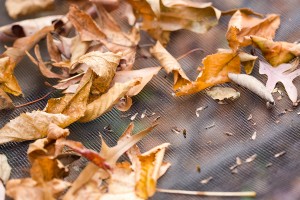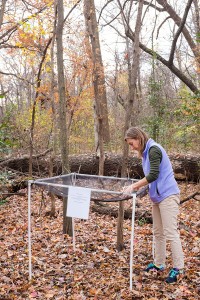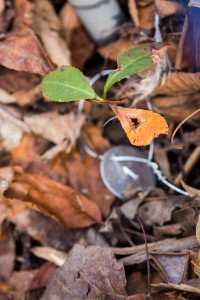Watching the Old Forest grow
In our previous blog post, we told you how students from Rhodes College are studying the Old Forest through examining what’s at the heart of its full-grown (or dead) trees. But there’s a lot to be learned from trees at a much younger life stage, too: their seeds.

Dr. Tara Massad of Rhodes College is conducting research on the Old Forest’s seeds, with the hopes of learning how well particular types of trees are regenerating. We’ve talked a lot over the past few years about how certain species of trees seem to be having trouble getting past the sapling phase. The oaks in the forest are either very small or very large, for example–there’s just not much in between, which means that when the old trees die off, they’ll be replaced by something else and the forest will look very different. But before we can figure out how to help those oaks regenerate, we have to assess the problem, and that’s what Dr. Massad is hoping to accomplish.
There are several possible reasons why we might not see as much regeneration as we’d like:
- Seeds falling from trees may not be reaching gaps in the forest floor (areas where they can receive the sunlight they need to germinate)
- The seeds may get to the gaps, but still not germinate for some reason
- The seeds may germinate, but insects may be over-consuming the foliage

To analyze these possibilities, Dr. Massad has set up paired traps in an area of the Old Forest–two inside a gap, and two placed nearby outside a gap. She and her Conservation Biology students periodically collect seeds from the traps and take them to the lab to identify, photograph, and catalog them. Some are planted in greenhouse space donated by the City of Memphis. This allows them to see whether seeds are growing more effectively in the woods or in a controlled environment.
Dr. Massad and the students also monitor any seeds that have germinated in the areas around the traps. Seedlings are tagged so that they can be monitored every few months. This shows the researchers whether there is a difference in the abundance and diversity of seeds that reach the ground vs. the seeds that actually germinate.
So far, Dr. Massad and her team are seeing a lot of ash, tulip poplar, hophornbeam, and sweetgum seeds. She says there wasn’t much to see in the gaps when the project started–the very definition of a gap is an area where trees falling have created an opening, so there aren’t a lot of available seeds in those areas. But, she says, “Just as storms can create the gaps by blowing trees over, we found that storms started to blow seeds into those areas too.”
This winter, the research was conducted in a single location using four traps, but Dr. Massad hopes to expand to 10 plots over the next few months. That will give the students ample opportunity to collect the seeds that fall in springtime, such as red maples. Having multiple plots also strengthens the research by showing whether findings can be replicated from one plot to another.
So what does Dr. Massad hope to learn from this research? “We’d like to learn that regeneration is happening in the gaps, but that it’s subtle. If that’s not the case and regeneration really is stalled, we need to figure out why–whether that’s because the forest is isolated, because it’s so impacted by the urban landscape around it, or other reasons.”

“We might find out that the quantity of seeds reaching the forest floor is too low, or that the seeds that do reach the ground are from shade-loving plants that wouldn’t thrive in the sunlight that reaches a gap. There could be too much leaf litter for the seeds to push up, or it could be too hot in the gaps. Some gaps are filled with vines that could be out-competing seedlings. There are a number of possibilities that we can study.” And a number possible solutions–for example, if the problem is that seeds can’t germinate effectively in the forest, perhaps some of those seeds from Old Forest trees could be collected, germinated off-site, and replanted once they’ve gotten established.
Although Dr. Massad is primarily interested in tropical ecology, she enjoys working in the Old Forest, and particularly with her students. There’s a lot of enthusiasm for Overton Park, and it’s an ideal environment for students to learn real-world applications of their curriculum. “Seedling ecology is important, even in a small forest,” says Dr. Massad. With her work, we hope to learn more about how to help the Old Forest thrive.



